Remember Vine? Despite its huge initial growth, the six-second looping video app was discontinued by Twitter in 2016 -- only four years after its launch.
Since then, we've seen apps like Snapchat and TikTok fill Vine's void. They both allow users to express their creativity while embracing short mobile videos and have attracted Gen Z and millennial audiences. They also feel more niche and non-traditional than older platforms, like Facebook or Twitter.
Snapchat, which launched in 2011, allows users to create video-based stories about their lives and send video or image-based messages to their friends. Unlike most other apps, Snapchat content expires either immediately or after 24 hours. This platform leads to users creating content that is more lighthearted on uncensored than other more public-facing platforms.
Meanwhile, TikTok, which launched in just 2017, is similar to Vine in that it allows users to create 10 to 60-second looping videos that can be seen on their profiles or can be algorithmically placed on feeds of users with similar interests or demographics.
At the moment, both apps continue to grow. Snapchat has 210 million daily users globally while TikTok recently passed 800 million monthly active users.
Despite each platform's growth, marketers in the social media realm are wondering, "Are either of these worth the hype? Or will they just become another Vine?"
To learn more about the strength of these two apps, I polled a U.S. audience of over 350 people to find out whether they regularly log into Snapchat, TikTok, or neither.
Given each app’s fast growth, you might expect both apps to have a close number of votes. You might also assume that TikTok is now surpassing Snapchat in general usage because the app has grown so quickly.
However, when I asked participants, "Which platform do you log into most often?", the results were actually quite surprising.
Which platform do you log into most often?
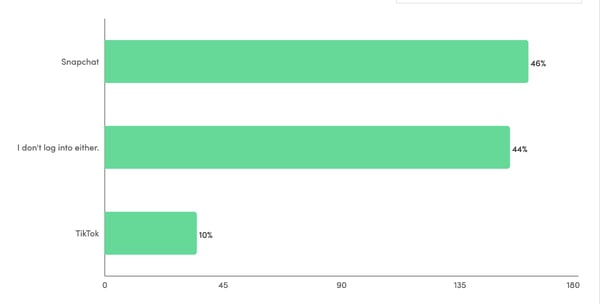
Data Source: Lucid Software
Shockingly, nearly half of those polled say that they use neither while the biggest chunk of participants logs into Snapchat most.
When looking at these results, it's important to note that we surveyed only a general U.S. population with no specific age demographics.
While it's helpful to know that a majority of the general population polled use Snapchat most often, you should keep in mind the growing stats that show how these apps are primarily used by younger age groups in Gen-Z or millennial age groups. Had we polled a global audience, the results might have been different as both apps are also heavily used in Asian and Middle Eastern countries.
While this survey hints that you might not want to put all of your energy into apps like TikTok if you're targeting a general or older audience, it’s still important to keep these apps on your radar or continue researching them if you want to market to younger generations.
Below, I'll walk you through the ins and outs of TikTok and Snapchat, the apps' distinct differences, and the marketing opportunities that each app could provide you now and in the future.
Snapchat vs. TikTok: A Head-to-Head Comparison
User Base
As mentioned above, Snapchat reports having 210 million daily global users, while TikTok has more than 800 million monthly active users.
Both Snapchat and TikTok claim to have mostly Gen-Z and millennial audiences with Gen Z making up the majority of both user bases.
According to 2019 data from Snapchat, 90% of 13 to 24-year-olds use Snapchat while 75% of 13 to 34-year-olds use the platform. Similarly, more than half of TikTok's global audience is under 34.
However, there is a slight gender variation. While 61% of Snapchat users are female, 56% of TikTok's global audience is male.
The two platforms also have incredibly global audiences. While Snapchat has a large number of users from Asia and India, TikTok has such a large user base in China that it has a Chinese version of its app called Douyin.
Platform and Features
Snapchat's format includes three main pages: a Friends page, the camera, and Discover. The Friends page shows a list of the user's friends where it allows them to open Snaps or see each user's Story. The other two pages are its camera and Snapchat Discover.
While the camera is pretty straightforward and easy to visualize, here are screenshots of the Friends Page and Discover:
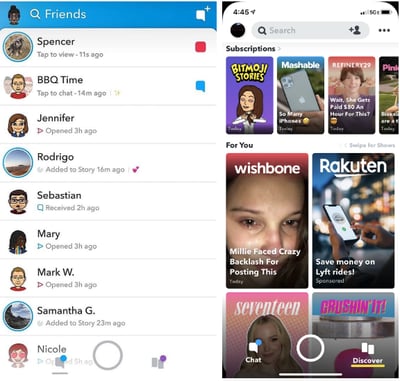
Discover is specifically for brands and publishers to post Stories. While the Friends page allows you to access Stories that have been filmed or created by friends natively in the app, Stories published by brands on the Discover page are often high quality and include graphic designs, edited imagery, animation, or production quality video. Here's a detailed post about how brands are leveraging Snapchat Discover.
TikTok also has a few central pages. One is a feed that allows people to see videos from their followers or that TikTok algorithms will think a user is interested in.
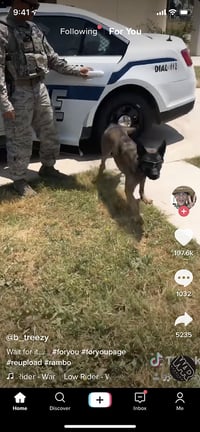
Aside from the feed, users can click on the Search page to see both a search box and highlights of all the trending topics on TikTok. The other two major pages are the app's camera and the user's profile page.
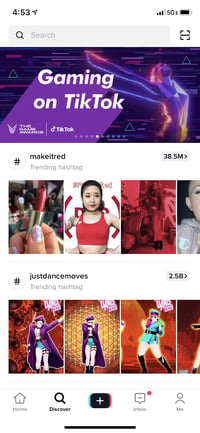
Want to learn more about how to navigate and create posts on each app? Check out our guides on how to use Snapchat and TikTok.
Content on Each Platform
Snapchat is primarily an app for friend-to-friend content which includes text and video-based messages that people post to their daily Stories or send specifically to friends. However, on the Discover area of the platform, marketers can create advertisements and Story editions with videos and graphics to promote their own products or services.
Here's an example of a Story from Snapchat Discover that highlights a Los Angeles-based manicurist.:
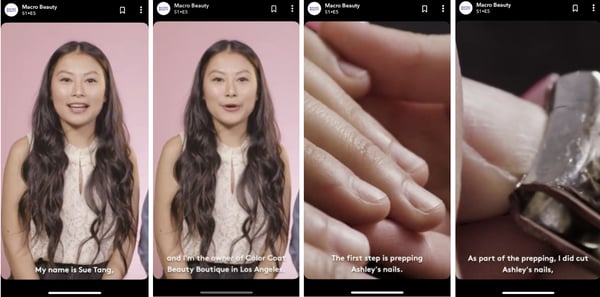
SInce TikTok allows you to instantly publish public videos, the platform is great for both branded and non-branded content. While the content you see on Snapchat is more like that of Instagram Stories, the content you see on TikTok is more like the content you used to see on the app, Vine. Like Vine, the content often presents short, looping skits, mini-music videos, or vlog-styled clips.
Here's an example of a branded video you might find on TikTok:
Both platforms allow you to film videos with stickers, special effects, and VR filters, but TikTok adds to the video experience by also allowing users to create videos with overlaid music, which you’ll hear in the example above.
Which platform is better for content marketing?
Each platform has its own pros and cons for content marketers. Here's what you should keep in mind about each.
TikTok
If you're aiming to target Gen-Z and on an incredibly limited budget, TikTok's app might be worth experimenting on. Because of the way the app is formatted, users can more easily find your company page, follow you, or search for your content than they can on Snapchat. You can also further optimize videos with hashtags and keywords.
However, if you're looking for website traffic, or don't have time to experiment with TikTok, you'll want to hold off for now. The platform is still highly experimental and only allows certain brands to link their videos to web content.
Snapchat:
On Snapchat, marketers will mainly thrive on the Discover page. While partnering with Snapchat to become an official Discover publisher might be inaccessible at the moment, you can still purchase ads on the platform that similarly allow you to tell users a visual Story about your product. These ads can even get high placement within Discover feeds.
One thing to note is that Snapchat Discover-based ads are much shorter than the Stories of Discover publishers. This means that if you want to create long-form Story content to highlight a product, service, or brand, you might want to try Instagram Stories or consider TikTok experimentation.
Aside from Discover, creating an individual account has not proven to be hugely beneficial for brands because users still have to friend them to see their content. Brands also can't add links to this content like they do with ads.
However, if you're looking to create short, bite-sized content for web traffic, conversions, or high placement on a social app that's popular with Gen Z or millennials, Snapchat's ad program still might be right for you because although the Stories you're allotted are shorter, you can still flex your creative muscles to quickly promote a product.
User Behavior
Both apps have one primary goal: to keep users entertained on their respective platforms as long as possible. And, based on TikTok and Snapchat stats, these applications do successfully keep users engaged.
Snapchat users spend an average of 26 minutes daily on the app and users create an average of 2.1 million Snaps per minute. Meanwhile, TikTok users spend an average of 52 minutes on the app daily as 90% of its user base logs in more than once a day.
When it comes to behavior related to products and ads, user bases of TikTok and Snapchat also vary.
Although Snapchat is an app that encourages connecting with friends, more and more users are beginning to use it as a part of their shopping process.
According to a 2019 Snapchat report, Snapchat users involve Snapchat in their buyer's journey 35% more than Twitter, 46% more than Instagram, and 58% more than Facebook. The report also claims that Snapchat ads provide a 7x return on in-store sales. This means that -- although Snapchat audiences are highly connected to the internet and mobile devices -- many of them will actually enter the advertiser's physical store to purchase a product.
When it comes to TikTok, there aren't many public stats related to advertising engagement just yet. However, brands have gone viral on the app, especially when creating hashtag challenges related to new product offerings. One example of this was Guess' #InMyDemin challenge. During the challenge, people posted videos of themselves in Guess' new denim clothing line. These TikTok videos then reportedly racked up a total of 3.8 million views.
As TikTok aims to gain more advertisers, you can probably expect to see more information coming soon about how users interact with advertisers. In fact, much of the data we have from TikTok originates from a recently-leaked pitch deck that the app company created for advertisers.
Which user base is better for marketers?
While Gen Z is flocking to TikTok, there's a broader age group of both Gen Z and millennials on Snapchat.
When looking at the poll in the intro, it's easy to tell that the general population logs into Snapchat more often than TikTok. Although users spend more time on TikTok, they also use Snapchat as a utility app to connect with friends and log into it multiple times per day. This might mean that people see value in the app, other than entertainment, which is the pure mission of TikTok's platform. This value from users might result in it being more stable and successful in the long-run, while TikTok could still just be a viral trend.
Marketing Opportunities
Both Snapchat and TikTok are trying to make their applications more enticing to advertisers. The two apps currently have offerings that cater more to bigger brands due to their pricing and requirements, however, it seems that they each have unique offerings that can still be used by smaller brands. Here's a breakdown of each.
Snapchat:
At this very moment, there are only two marketing options for brands on Snapchat and they're both more accessible to mid-sized or large companies than smaller businesses. The first, and seemingly most profitable, is advertising. Snapchat advertising has been seen to provide ROI related to both in-store and online store purchases.
Snapchat ads also allow you to present your ads in Snapchat's Discover, similarly to branded publishers. However, unlike Snapchat Discover publishers, you can link ads or paid mini-Stories to your website, which could be beneficial to your traffic or online conversions.
Posting Stories as a publisher on Snapchat Discover is the other option. However, to become a publisher, you need to have a specific contract with Snapchat rather than simply signing up online. You also need to create Story-styled, original content that really engages with users. Discover publishing is also meant to keep users in the app, meaning that you won't be able to place links into this type of content.
To learn more about how brands are leveraging both ads and Stories on Snapchat Discover, check out this blog post for a detailed list of examples and takeaways.
TikTok:
TikTok only launched in 2017, but it's already expanding its advertising options. They're also taking steps to make content creation in the app more brand-friendly. Most recently, it even allowed some accounts on the platform to start placing links to ecommerce sites into their videos.
According to recent reports, however, advertising on TikTok is incredibly expensive and requires a large budget. Some publications have even referred to it as "the wild west." So, this might not be incredibly accessible to smaller brands.
However, brands on TikTok can still create content, grow their audiences, get their accounts verified, and begin placing links in their content or profile page's bio area. This means that TikTok shows slightly more potential for branded content than Snapchat.
Which is more brand-friendly?
At the moment, marketers interested in branded content should consider looking into or experimenting with TikTok. Creating this content is free and because the app is so new, there are fewer norms related to what content is engaging and what isn't. This means it's a great place to experiment and test the waters, especially if you want to engage with teens or young adults.
Although Snapchat is still lacking when it comes to free content creation marketing opportunities for smaller brands, the company has been adding more advertising options and now claims to have offerings for "every business." And, according to Digiday, a growing number of U.K.-based brands are now putting more of their social media advertising spend into Snapchat.
And, as mentioned above, Snapchat ads allow you to link to your website or online store, while only a few content creators on TikTok are permitted to place links in their content. This alone means that Snapchat ads are better than general TikTok strategies if you want your marketing efforts to result in traffic or conversions.
Weighing Snapchat and TikTok
When comparing Snapchat and TikTok specifically, Snapchat is still more stable and more heavily used by general populations than TikTok. Snapchat ads also have a track record of providing ROI and the company is continuing to increase ad offerings to make the app more brand-friendly.
Although Snapchat and social apps like Instagram might be better suited for your strategy right now, don't disregard TikTok. This app's massive growth and move to be more brand-friendly shows that it's positioning itself to be more than just a viral trend.
Additionally, although Snapchat is more mature, TikTok's nascency makes it a great place for side experiments -- especially when they target Gen Z. Not only is content creation free on the app, but the platform is so new that nearly everything is experimental. This means that there aren't many norms saying what can or can't be engaging content.
If your goal is to grow traffic and conversions from both Gen-Z and millennial audiences with one of the two apps, you'll want to leverage Snapchat ads over TikTok. However, you should still keep both on your radar because each app is growing and can provide insights on trends related to younger audiences.
If you're more interested in marketing to professionals or those in B2B industries, table these platforms and focus on the more traditional social media networks.
To learn more about TikTok, check out this piece which details the app's history and growing user base. If you're still interested in learning about Snapchat, here's a guide on how to use the platform.
No comments:
Post a Comment